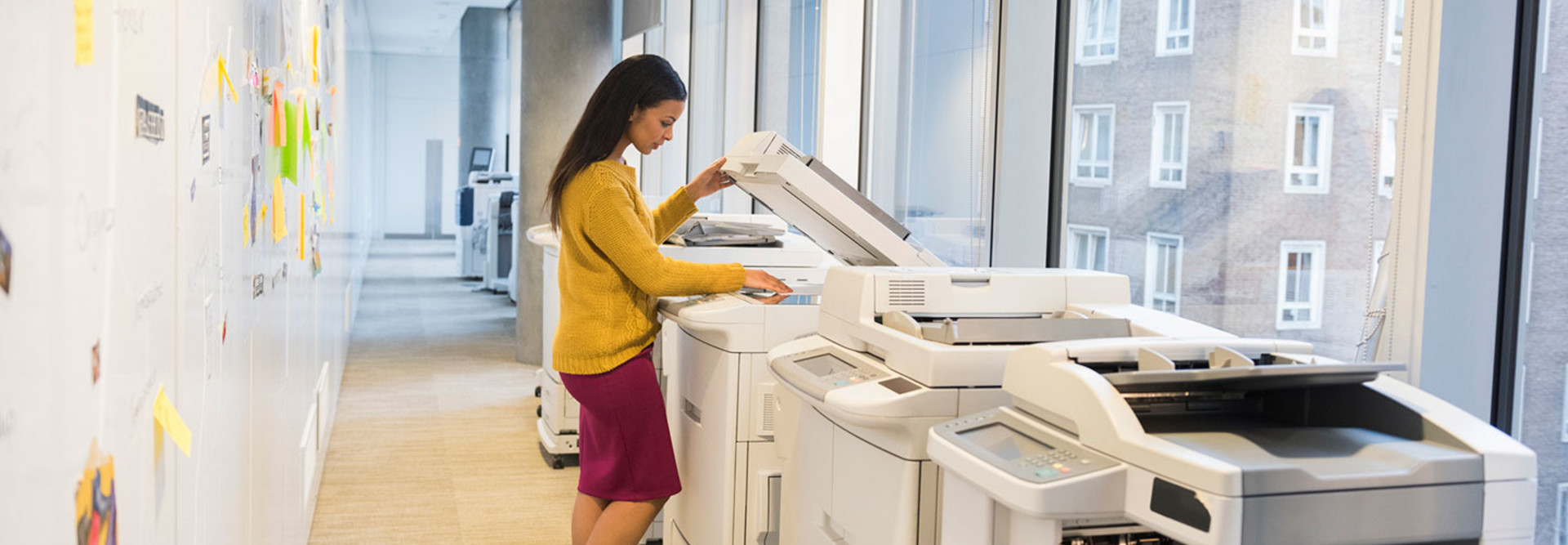How Printers Can Boost Productivity in Your Office
In most offices, nearly all employees use a single device to manage, process and share some of their company’s most valuable data.
That device? The printer.
While printers and multifunction devices have come to be viewed as “appliances” in some workplaces, the truth is these devices can be the source of huge gains in business productivity – or losses, depending on how they’re used. This has always been the case, but it’s especially true now that manufacturers are producing machines with new feature sets designed for how employees want to work.
“The workplace is inundated with unstructured data, and much of it is tied to older, hard-copy processes,” says Matthew Raab, manager of global product marketing for Xerox. “Today, we have powerful devices with capabilities that help businesses to really attack that problem and help their workers to be more productive.”
Valerie Alde-Hayman, an analyst with Gap Intelligence, says the value proposition for printers and multifunction devices has changed. Whereas organizations once were focused on “feeds and speeds,” she says, they’re now concerned with how the tools can enhance productivity and cut costs.
“We’re witnessing a shift away from printers being viewed as just hardware,” Alde-Hayman says. “More and more, printers and multifunction devices are seen as solutions that can solve problems for end users.”
Touch Screens Offer More Functionality
Printers have featured touch displays for many years, but recently these displays have come to more closely mirror the interfaces of consumer mobile devices such as smartphones and tablets, giving users a familiar, customizable and intuitive experience.
“The biggest advantage is that users don’t need to be trained,” says Raab. “They know how to use the device right away.”
In the past, Raab explains, many organizations trained only a handful of workers on how to execute specialized print jobs. “As the workplace has shifted, you don’t necessarily have people specializing on specific devices,” he says. “Now, people can walk up to a device and see the apps, and the screen works just like you would expect a mobile device to work.”
The tabletlike interface is a key component of Xerox ConnectKey Technology, which the company bills as its “answer to the ever-changing office environment.”
Xerox itself has several apps designed to enhance and simplify printing, copying and scanning. Many organizations have also created their own apps. One bank, for example, created an app that cut its invoice processing time by 75 percent, Xerox says.
Get Easy Access to Cloud Tools
Xerox ConnectKey technology allows users to access cloud tools such as Dropbox, Google Drive and Microsoft OneDrive directly from printers and multifunction devices. This means that a user can walk up to a device and print directly from these services without ever touching a laptop, desktop or other computing device. It also means that users can scan a hard copy of an important document and instantly upload the file to the cloud — eliminating cumbersome steps that previously sapped productivity, while ensuring the document is secure.
“In the past, you would have to digitize a document, email it to yourself, go to your computer and then upload it,” Raab says. “This change is a recognition of how people are working differently today. We’re giving them tools they already use, so they can work in the ways that they want.”
Gain Productivity with Translation Capabilities
Features such as Xerox Easy Translator Service allow organizations to automatically request translation services from their print devices, rather than spending time searching for a viable way to outsource their translation work.
“Translation is becoming more of a hot-button issue, especially for worldwide organizations,” Raab says. “A user can choose whether they just want machine translation, or there are other levels — up to, and including, human translation.”
The Xerox feature gives users access to more than 40 languages from around the world. The tool is especially helpful for small and midsized organizations that have the need to translate documents but lack sufficient expertise on staff.
Search Scanned Documents
Optical character recognition enables organizations to convert scanned paper documents, PDF files and other images into editable and searchable data. Increasingly, built-in OCR is becoming a standard feature on enterprise printers and multifunction devices, helping organizations to store and manage their data in a way that facilitates — rather than impedes — productivity.
“Before, the only way employees could retrieve a document was to give it a name and add some metadata,” Raab says. “Now, whatever you scan becomes searchable. In the past, you might have been able to scan something, but if you didn’t tag it exactly right, there was no way to find it later on.”
Built-in OCR can sometimes result in entire new digital repositories, especially if much of an organization’s essential data currently “lives” in paper files. For example, one midsized hospital is using its multifunction device to scan and digitize all its patient records and create an electronic medical records system. The documents are stored in a cloud-based repository, which can be easily accessed and updated.
“Knowledge workers spend a great deal of their time looking for information,” Raab says. “Today, it’s unacceptable to expect someone to wade through 200 pages to find the one little tidbit they’re looking for.”
OCR features are just one way printers are becoming full-service productivity tools. As advanced capabilities such as translation services and cloud tools become more common, users are finding new ways to solve their problems and get work done.
Learn more about how CDW and solutions from Xerox can help your organization improve efficiency and productivity.










